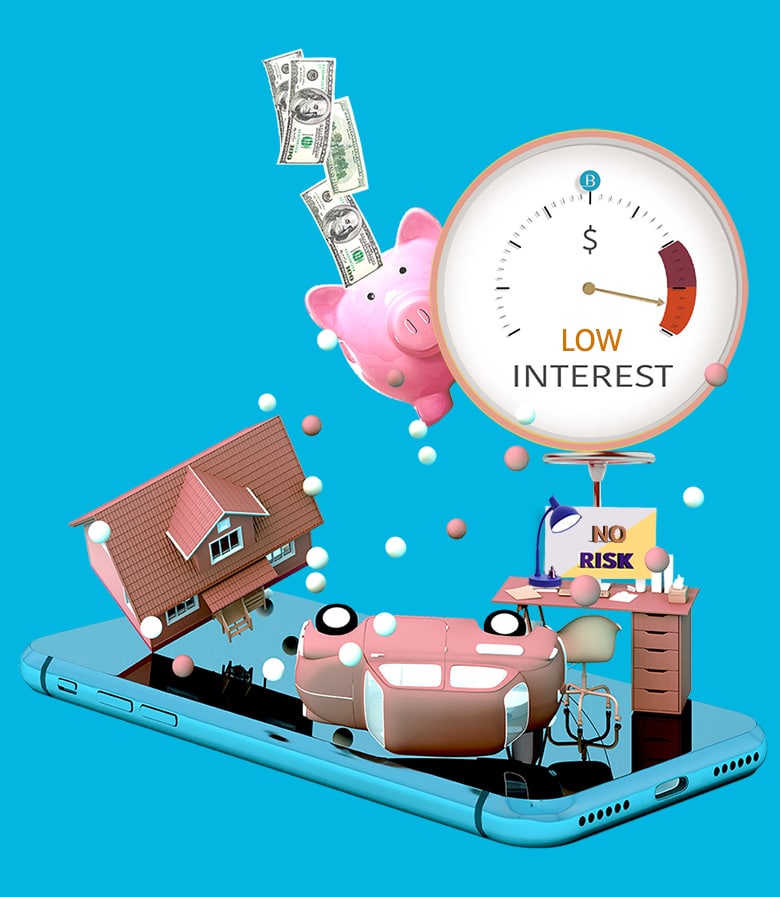
Dealing with financial stress while waiting for a lawsuit to settle is tough. Pre-settlement funding offers a lifeline by providing you with the essential funds for living expenses, medical bills, and other urgent costs without the wait.
On the flip side, the cost of such funding can significantly vary and impact how much money you have left after your settlement arrives. That’s why it’s imperative that you select a lawsuit loan company that gives you the most favorable terms.
To help you secure pre-settlement funding with low costs, we’ll walk you through understanding the main factors that affect pricing and offer tips to get the best possible deal.
Key Points:
- Pre-settlement funding provides an advance on your expected lawsuit settlement, helping you manage living expenses and urgent costs without waiting for the case to settle.
- Interest rates and fees on these loans vary; understanding the differences between compounding, simple, or time-reduced interest rates, as well as fee structures and rate caps can help you minimize your costs.
- A simple interest rate and capped rates offer the most cost-effective options in the long run, protecting you from escalating costs over time.
- The choice of lawsuit loan company significantly impacts your final costs; opting for a lender with transparent terms, competitive APRs, and caps can ensure more of your settlement stays in your pocket.
A Brief Understanding of Pre-Settlement Funding.
Pre-settlement funding provides a financial advantage by offering you an advance on the settlement you expect from your lawsuit.
Unlike traditional loans that might burden you with upfront costs, personal credit history, and monthly repayments regardless of your case’s outcome, a settlement advance is tied to the success of your lawsuit. That means you only repay the funding company (plus any fees, like application, underwriting, or processing fees and interest) from the financial compensation you receive.
And if your case doesn’t resolve in your favor? There’s no obligation to repay the funds.
How to Get the Best Pre-Settlement Funding Costs.
Understanding the costs tied to settlement loans—like the types of interest (compounding, simple, or time-reduced), fees, and the implications of rate caps—is key to securing an advance that meets your financial needs, so most of your settlement remains where it belongs—with you.
Here are a few things that can help you improve your chances of getting the lowest-cost pre-settlement funding:
- A simple interest rate. A simple rate can increase your chances of getting a lower cost for your lawsuit loan.
- Capped rate. Rate caps can save you from incurring exorbitant repayment amounts by limiting the amount you repay to a certain figure regardless of how long your case takes to settle.
- APR or 6-month trench. An APR can help you get a fuller picture of what you’ll be charged yearly or every 6 months, allowing you to choose the most convenient option.
Your Type of Interest Rate Matters
A pre-settlement funding interest rate is the cost of borrowing money against your future settlement. With legal funding companies offering varied rates, it’s tempting to zero in on the lowest one. However, a low interest rate doesn’t always guarantee the cheapest pre-settlement loan. Your cost will ultimately depend on the specific terms, conditions, and pricing structure in the lawsuit loan agreement.
Compound interest rates
Compounding interest on a lawsuit loan agreement means that interest is calculated not only on the principal but also on any accrued interest every month. This exponentially increases the total you owe, especially if the legal case is drawn out over a long period.
For example, a small 2.5% monthly rate on a $5,000 advance could double the amount you owe in just two years. In other words, a pre-settlement loan with compound interest quickly snowballs, turning what looked like a low-cost option into one of the priciest.
Time-Reduced Interest Rates
Beyond the common compound interest rate, you might also come across with what’s known as a “time-reduced rate” or “tiered rate”. This type of rate decreases typically after one year, so the longer your lawsuit, the less interest you pay. The downside is, if your case is resolved quickly, say in a year, you might be hit with a high interest rate, as high as 80%.
Another major drawback of this model is also the restriction on additional legal funding, leading to high charges for any extra money within the first year or even an outright refusal to provide more funds.
Simple Interest Rates
A simple interest rate on a lawsuit loan is calculated on the principal amount you borrow and remains the same throughout your case. This means you won’t pay interest on interest, making it easier to predict the total cost when your case settles.
To avoid the pitfalls of time-reduced and compound rates, a pre-settlement loan with a simple interest rate can be a wise financial decision. Its greatest benefit? Transparency and predictability—especially when considering the long haul.
The Importance of Capped rates
A ‘capitalization rate’ is a clause that limits either the maximum interest rate a lender can charge or the maximum duration interest can be accrued on a lawsuit loan. For example, with a 100% cap, no matter the twists and turns your case takes, the interest you owe will never exceed that “100% cap” or predetermined limit. This makes a settlement loan with a capped rate one of the lowest options when compared to uncapped rates.
Evaluating Loan Costs Through APR and the 6-Month Trench
The APR, or Annual Percentage Rate, offers a comprehensive look at what your lawsuit loan really costs per year, as it combines both the interest and any additional fees into one percentage. There’s also something known as a six-month trench, which shows you the total cost of your loan for half a year.
Although the APR and six-month trench provide clear figures on what you’ll be paying annually or semi-annually, your final repayment will depend largely on how quickly your settlement is reached and if you have a cap.
Comparative Example of Loan Costs Over 5 Years:
| Loan Option 1 | Loan Option 2 | |
|---|---|---|
| Interest Rate | 3% simple per month | 3% compounding per month |
| Cap | 2 year cap | No cap |
| Loan Amount | $2,000 | $2,000 |
| Additional Fee | $250 | $250 |
| Total Repayment (over 5 years) | $3,690 | $12,034 |
| APR Impact | Lower APR | Higher APR |
Explanation:
- Option 1: Offers a 3% simple monthly interest rate with a cap at 2 years, meaning interest won’t accumulate beyond that period. Even if the case settles in 5 years, the total cost including the loan, capped interest, and fees is $3,690.
- Option 2: Also has a 3% monthly compound interest rate but with no cap. If the case takes 5 years to settle, the total cost, including interest and fees, rises to $12,034.
Breaking Down Fees
Pre-settlement funding fees are typically one-time costs added to your loan for processing and administration. These are separate from any interest that might be charged on the amount you borrow.
One-Time Fees and No Interest Charge
Some lawsuit loan companies offer a ‘one-time fee’ with ‘no ongoing interest charges’. This fee is applied each time you receive funding and is calculated as a percentage of the advance amount, typically around 30%.
While a “no interest, one-time fees” loan is ideal and cheaper for a single advance, civil cases, particularly personal injury, can extend unexpectedly. If your pending lawsuit delays and you need more financial support, a new ‘one-time fee’ applies to each additional advance. As a result, the total cost of your pre-settlement loan can escalate quickly.
Balancing Fees and Interest Rates
When shopping for a lawsuit loan, you might also notice some options that include both interest rates and additional fees. At first glance, this combination might look more expensive due to the extra charges. But is it really? Not necessarily. If the loan’s total Annual Rate remains lower and includes caps, this might end up being your lowest-cost option in the long run compared to alternatives without any caps.
12 Factors that Increase or Decrease the Cost of a Pre-Settlement Loan Rate.
Understanding the factors that influence the cost of pre-settlement funding is the first step toward securing the best possible rates. Here’s how you can use these factors to your advantage:
1. Size of the Advance
Borrowing less from your lawsuit directly translates to decreased pre-settlement funding costs. It might seem counterintuitive, but requesting funds as and when your needs arise, rather than a larger upfront sum, is financially smarter. Here’s why: interest accumulates on the total amount borrowed from the get-go.
For example, if you borrow $40,000 but only immediately need $5,000, you’re incurring unnecessary interest on unused funds sitting in your bank overtime.
To manage this wisely, limit your borrowing to essential expenses by pinpointing your financial requirements early on and sticking to a planned budget. However, try to anticipate future needs as well. This way, you can request additional settlement loans if you need it.
Tip: Discuss your immediate needs and potential future requirements. A reputable funding partner will work with you to devise a funding plan that minimizes interest costs and aligns with your case timeline.
2. Additional Funding
At times, despite your best efforts, legal proceedings can drag on, potentially draining your resources thin, and with the need to seek further funding. While requesting additional funds when needed is cost-effective compared to a lump sum, each new loan has its own set of interest rates and fees. That means the more you borrow against your case, the more you’ll need to pay back in interest.
Remember, approaching legal funding with a strategy that balances immediate needs against future costs helps you remain financially stable while your case is pending and protects your future settlement from being overly diminished by repayment.
3. Your Attorney’ Reputation
More and more pre-settlement funding companies often offer more favorable rates to clients represented by highly recognized attorneys with a strong track record of winning high-value claims.
These attorneys have spent years, sometimes decades, perfecting their skills in the courtroom, have access to extensive resources for thorough case preparation, and hold a level of credibility that can positively influence the outcome of your case.
Lawsuit loan companies recognize the value these attorneys bring and the increased likelihood of a successful case outcome, which in turn reduces their risk. It’s like having a star player on your team; everyone expects good results. That’s why having an attorney with a solid reputation might not just help you win your case but also make your lawsuit loan cheaper.
4. The Strength of Your Case
The complexity of your lawsuit also dictates your pre-settlement funding terms. Cases that have a good shot of success often lead to some of the lowest-rate settlement funding, as the legal funding company might see you as a safer bet.
Ways to strengthen your case:
- Organize and Review Your Documentation. Make sure all relevant case documents are thorough and accessible. This includes medical records, incident reports, and any correspondence related to your case.
- Collaborate Closely with Your Attorney. Discuss strategies to improve your case’s strength, such as gathering additional evidence or expert testimonies.
- Prioritize Medical Treatment for Your Injuries: Untreated or under-treated injuries could lower your case’s value and, by extension, your legal funding costs. Follow through with all recommended treatments and surgeries to accurately document the extent of your injuries. And if you’re underinsured or uninsured, Baker Street Funding can fund your medical treatment at the lowest cost.
5. The Duration of Your Case
Before applying for a pre-settlement advance, make sure you have a clear understanding of how long your case is expected to last. If you can, try not to get funds too soon in the litigation process to keep your overall cost low. This is because the longer the lawsuit, the longer the term’s length, and subsequently, the accumulation of interest. Even with a capped rate, you’d pay less if your case settles in a year instead of two.
Pro Tip: While it might seem beneficial to settle your lawsuit quickly to reduce charges, rushing can lead to undervaluing your settlement and getting less than you deserve. Be realistic about the true worth of your case and balance immediate monetary relief with long-term financial health post-settlement.
6. Lawsuits with Settlement Offers
Lawsuit loan companies view rejected settlement offers as a sign that the case has a strong chance of settling sooner rather than later, making it an essential piece of information for securing a lower rate.
If there’s a settlement offer on the table, inform your funding company. Even if you’ve declined it, these offers not only signal the defendant’s willingness to resolve the case but also indicate a high chance of case resolution, a shorter funding period, and the lessening of the risk to the lender. This ultimately impacts your pre-settlement funding rates positively.
7. Choice of Legal Funding Company
Not all lawsuit funding providers are created equal, and the choice you make today will determine how much of your settlement you end up with. The best pre-settlement funding companies pave the way with the most competitive costs (keeping your financial well-being in mind). But others might present options that, while tempting, could lead to higher costs down the line and significantly reduce your settlement or lawsuit award once it is paid out.
If you’re feeling overwhelmed and don’t know where to begin, keep in mind that you have options:
- Seek Transparency and Fairness. Start by looking for a trustworthy legal funding company with transparent terms, low rates, and good customer reviews. A reputable company’s openness about loan costs can save you from unexpected charges on your settlement.
- Compare Options. Comparing different lawsuit loan companies allows you to benefit from the market’s competitive nature, which could lead to more favorable repayment terms.
- Negotiate When Possible. Be aware that some funding companies may adjust their rates to either match or beat a competitor’s offer, potentially lowering your costs.
- Explore Brokers Too. Although some brokers might add additional fees, those who are skilled and reputable could secure cheaper loan costs than what direct lenders might offer. For the most thorough comparison, make sure that the loan doesn’t exceed a certain amount after a period of time and keep an eye on the APR or 6-month trench.
The fact remains, choosing a pre-settlement funding company is more than a financial decision; it’s a step towards protecting your financial welfare and making sure your settlement works for you, not against you.
8. The Economy
Inflation’s Impact
General economic conditions, like inflation, can also affect the cost of pre-settlement funding. When inflation is high, the value of the money you get from your settlement decreases and it might not cover as much as you’d expect—your dollar doesn’t stretch as far.
On the other hand, when inflation is low, the money you borrow can be more valuable, meaning you get more bang for your buck. This makes the cost of pre-settlement funding effectively less in times of low inflation because the value of the money you receive is higher.
If inflation is high, leverage periods of lower inflation and interest rates, and find alternative sources of financial assistance.
The Federal Reserve
The Federal Reserve, which controls the United States’ monetary policy, can indirectly impact pre-settlement loan costs, too. If the Federal Reserve decides to lower interest rates, borrowing money becomes cheaper overall. This can lead to lower rates for your legal funding since the lenders providing these advances have lower costs.
Conversely, if the Federal Reserve increases interest rates, the cost for financial institutions to borrow money goes up. As a result, pre-settlement funding companies might increase their interest rates to cover these higher costs, making your loan more expensive.
It’s similar to how gas prices change; external factors can make things costlier or cheaper.
Recommended: Ways to protect your lawsuit loan during inflation
9. Refinancing a Previous Advance
Refinancing your existing pre-settlement funding can seem like an extra effort, but it’s a smart move for reducing your costs over time. Here’s how it helps:
By transferring your loan to a lawsuit loan company that offers lower interest rates, you’re taking a step towards preserving a larger portion of your future settlement. This strategy not only helps you retain more of your settlement proceeds but also reduces the financial burden imposed by higher costs. In short, refinancing allows you to lessen what you owe in costs and increase what you keep from the settlement.
Recommended: Can I get additional pre-settlement loans?
10. Settled vs. Pending Claims
Settled cases usually lead to much better terms for a lawsuit loan because they’re less risky for the lender. Before a case is settled (during the ‘pre-settlement’ phase), there’s a lot of uncertainty, and the funding company has to predict whether you’ll win your case or not.
However, once your case is settled and it’s clear that you’ve won, the risk for the funding company drops dramatically. That’s why funding against settled claims (‘post-settlement’ loans) often has lower costs.
In light of this, consider adopting a “less is more” mindset to ensure you don’t sacrifice your hard-worked personal injury settlement unnecessarily. It’s wise to borrow the minimum amount needed, and only if absolutely necessary. If you’re not careful, you could end up with significantly less settlement money.
11. Who’s Applying
Sometimes, the secret to locking in a better rate on your lawsuit funding lies in who does the talking. Here’s a little insider tip: when your attorney handles the application for you, it can open the door to more favorable terms. In other words, your attorney’s approval of your loan application signals a strong case and professional scrutiny, which encourages lenders to put their best offer forward.
Asking your lawyer to help with your pre-settlement financing application with the company of your choice can secure you more advantageous funding rates and savings on your final settlement.
However, caution is advised: Some attorneys may have existing relationships with certain funding firms, not all of which will offer the best rates. For this reason, don’t hesitate to ask your attorney why you’re being recommended a particular lender. Additionally, demand that you review the legal funding agreement in full and personally verify the terms to protect yourself against excessively high rates.
12. Judgment Appeals
When your case is appealed, it’s under review again. This means the initial trial’s decision might change—it could be confirmed, overturned, changed, or even lead to a new trial. Due to this unpredictability, funding companies often view appeals as higher risk, which might influence both your ability to secure funding and the costs involved.
So, before you look into legal funding during an appeal, think critically about whether you truly need funding at this stage or if there are other ways to manage your financial needs. Understand that approval might be tougher, and if you do get funded, it could be at a much higher cost.
Consider weighing these costs against the financial relief the funding would provide.
Secure the Lowest Cost for Your Lawsuit Loan by Thoroughly Reviewing Your Funding Agreement.
Understanding the specifics of your pre-settlement funding contract is crucial to avoid unexpectedly committing a large part of your settlement to a lender. Before making any commitments:
- Carefully Review the Entire Contract: Make sure to read through the whole contract carefully and verify that all rates and fees are fully disclosed. Be cautious of lenders who don’t show you the full details or who pressure you to sign quickly—this could mean they’re hiding terms that aren’t in your favor.
- Demand Full Transparency. Insist on a clear breakdown of what the funding will cost you, including any caps, fees, and interest rates. Transparency isn’t just beneficial—it’s your fundamental right.
- Seek Clarity on Every Clause. If any part of the contract is unclear, request a detailed explanation. A reputable lender will be ready and willing to provide clear answers.
- Consider the Long-Term Impact. Consider the long-term impact of the agreement on what percentage of your financial recovery will have to be repaid after your case is settled.
- Ask Your attorney for Feedback. Your lawyer understands the value of your personal injury lawsuit and can guide you on whether the funding terms make sense for your situation.
- Compare Multiple Contracts: Don’t settle on the first funding agreement you receive. Instead, compare rates, fees, and terms from several lawsuit advance lenders. This comparison can highlight differences in costs and help you identify the most inexpensive option. Remember, even small differences in lawsuit loan rates or fees can significantly affect the total amount you owe.
Straight Talk
Making an informed choice about legal funding means understanding the factors that influence costs inside and out and taking steps that position you more favorably for approval. (Apply now)
Calculate Your Pre-Settlement Funding Rate with a Lawsuit Loan Calculator.
Want to learn more about lawsuit funding costs? Our lawsuit loan calculator is an accurate online tool that helps plaintiffs estimate the potential cost of the loan.
It works by inputting the funding amount, the expected length of the funding period, and the estimated interest rate. Based on this information, the calculator will estimate the total repayment amount, including both the principal amount and the interest rates.
The Takeaway
Pre-settlement funding can be a great option when financial strains from a pending lawsuit loom large. Remember, the path to securing a financially sound future, even before your settlement clears, highly depends on making informed choices about your funding options.
Ask yourself: Are you getting the best possible interest rate? Does your funding agreement include a fee structure that works in your favor over time? Are there caps in place to protect you from escalating costs? These questions aren’t simply food for thought—they’re essential considerations that can dramatically impact the net amount of your settlement.
A pre-settlement loan that seems cost-effective upfront but accumulates higher fees and interest over time can quickly erode your final settlement amount. Conversely, opting for a lender that offers transparent terms, capped interest, and competitive APR’s can guarantee more of your settlement remains in your pocket, where it belongs.
Armed with knowledge and supported by a team dedicated to securing your financial well-being, taking the leap towards applying for pre-settlement funding becomes less about wondering about uncertainties and more about stepping confidently towards financial stability.
At Baker Street Funding, we prioritize your financial security above all else, offering some of the lowest pre-settlement funding APR‘s with caps designed to protect you. Begin with a simple application, and let us assess your case for a lawsuit cash advance, with no obligation on your part and absolutely no risk involved.
In the end, this isn’t just about getting through today—it’s about securing your future with the lender that leads you to a stronger financial position post-settlement. Apply today.













